Arachnula impatiens
Arachnula impatiens is a very large protozoan (single celled organism) common in soils and on moss and lichens around the globe.
It belongs to the so-called vampire amoebae (vampyrellids), which get their name from their specific way of feeding.
Arachnula is a voracious predatory protozoan that moves quickly between soil particles in search of prey, often with several ‘arms’ extending in many directions from the cell body – hence its name which translates as ‘impatient spider-like amoeba’.
In spite of being a single cell, Arachnula is so big - up to 1 millimetre - it can attack a large variety of prey ranging from bacteria, diatoms and fungal spores to filamentous algae and fungi or even small animals like nematode worms and rotifers.
Arachnula and its relatives are very interesting because they play a key role in microbial food webs.
They are also potential biological control agents for tackling:
- algal blooms in water systems
- pathogenic fungi and nematode worms in forestry and arable soils
Species detail
-

Taxonomy
Fewer than 20 species of vampire amoebae have been described so far, but researchers at the Museum are working hard to characterise more. Discover how cell extensions called pseudopods can be used to separate existing amoebae into two major, very ancient groups.
-

Distribution and habitat
Vampire amoebae live almost anywhere, as long as there is water around. Arachnula impatiens lives in soil, in the film of water surrounding soil particles. Find out what happens when the soil dries out.
-

Biology
There are two phases in Arachnula impatiens’s lifecycle - feeding and digestive phases. Discover what we know about this organism’s reproductive cycle.
-

Behaviour
Get a taste of this vampire amoeba’s eating habits and discover what inspired its name.
-

References
Get more reference material for Arachnula impatiens.
Images
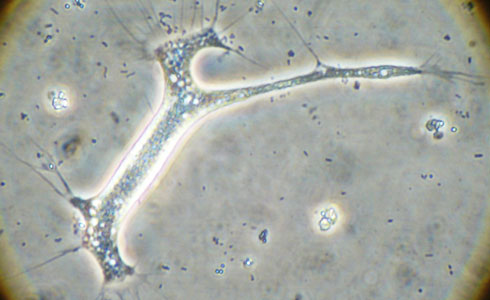
Arachnula impatiens in all its extended pseudopods glory.
© C Berney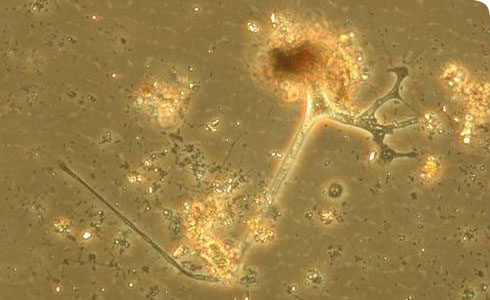
Arachnula impatiens moving around soil particles in search of a prey
© C Berney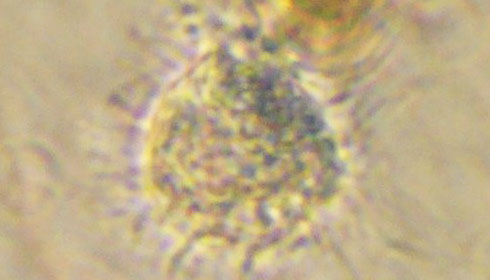
Arachnula impatiens contracting before going into a cyst
© C Berney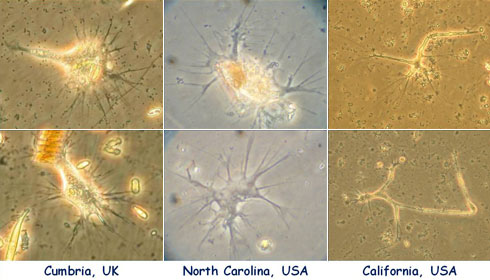
Gallery of three unnamed marine relatives of Arachnula impatiens recently isolated by Museum researchers.
© C Berney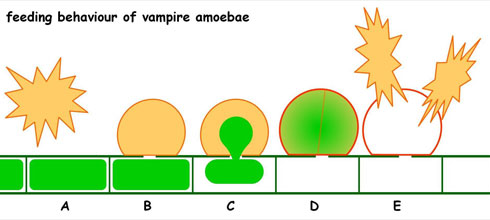
Schematic drawing of the feeding behaviour of Vampyrella lateritia, a close relative of Arachnula impatiens. Vampyrella lateritia approaches a filamentous alga (A), attaches to it and bores a hole in the algal cell wall (B). The vampire amoeba sucks up the content of the algal cell (C), then forms a digestive cyst (D) within which it usually divides by asexual reproduction. Later, one or more Vampyrella cells leave the digestive cyst (E).
© C BerneyAuthor
Dr Cédric Berney
Postdoctoral Research Assistant / Microbiologist, Department of Zoology
Dr Cédric Berney’s research interests and expertise are in the evolution, biodiversity and ecology or protozoa. His current project at the Museum focuses on the biodiversity of large naked amoebae - like Arachnula - and its relatives and the role they play in microbial food webs in all ecosystems
A word from the author
'I think Arachnula impatiens and its relatives are the coolest creatures on Earth. The way these single celled organisms move around is otherworldly, as if they were straight out of a sci-fi movie. But importantly these very diverse protozoa are also unrecognized key players in most ecosystems at a microscopic level, helping to regulate algal and fungal growth. It is essential that we learn more about the biology, diversity and ecology of these fascinating organisms.'
